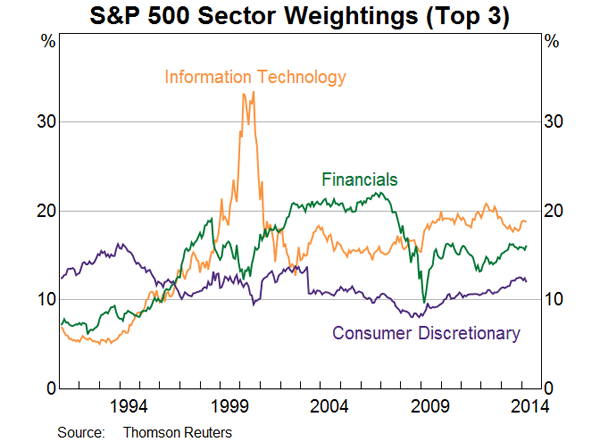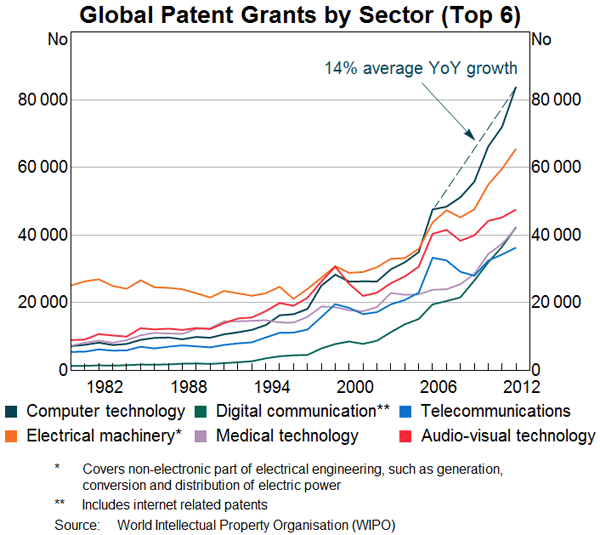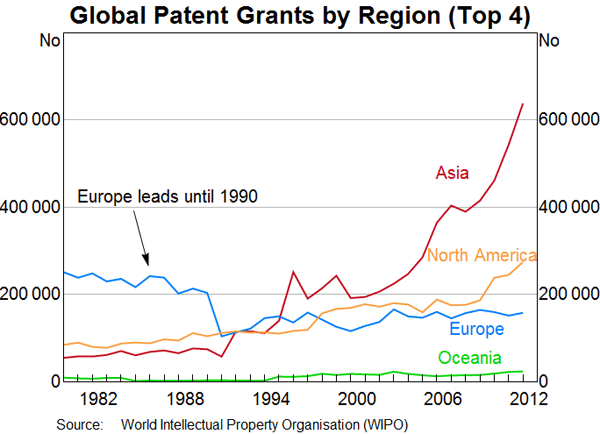Speech Digital Disruption – Opportunities for Innovation and Growth

Sarv Girn
[*]
Chief Information Officer
Speech to the Committee for Economic Development of Australia (CEDA) Adjusting Australia Series
Sydney –
- Audio 14.15MB
- Q&A Transcript
Digital Disruption, it is an opportunity of a lifetime, but on the other hand it is also littered with risks. If you are an executive of a business or a director on a board then the challenge is to determine if the right balance has been achieved in these extremes.
The biggest risk of all however is to not do anything at all – ignoring the waves of digital disruption in business and society has led to extinction for many. You only have to look at the likes of Nokia – which in spite of owning 30 per cent of the world's mobile patents (GSM) finds itself struggling to stay relevant; Kodak invented the digital camera technology, but failed to capitialise on it; General Motors – produced the first commercial electric car almost 20 years ago, stopped its rollout, and now finds itself trying to catch up with the Japanese hybrids; bookstores, the music industry and newspapers – all of which were the giants of their time, and now find themselves trying to avoid extinction.
If as an executive in a business you walk away from this event without any actions of your own in digital disruption then that will be a failure.
Digital disruption brings many opportunities for innovation and productivity outputs. Over the next 15 minutes I will cover three key areas:
- First, a brief definition of digital disruption and how it's different from continuous improvement;
- Second, the opportunity around us in the digital environment; and
- Finally, how to deal with disruption as an executive or board member.
I would hope from this you will get a very good feeling of why your organisation should act to harness the many growth opportunities around us by building digital innovation into the goals and DNA of your organisation.
Digital Disruption Defined
Let's first start with the definition of digital ‘disruption’. The word ‘disruption’ is very interesting. I'm not sure when and how the meaning took a twist from what I think many of us would have understood this to be when we were kids. When I was at school, often, and I would probably say very often, the teacher would say ‘stop being disruptive’, ‘you are a disruptive child’. Of course that was never said to me, and if I look at each of you in the audience I don't think you were disruptive either. We were all very well behaved!
So when did we start to use the term disruption with innovation and change? Has anybody heard of a person named Clayton Christensen? Clayton Christensen has been a key force behind the concepts of disruption and innovation over the last 20 years. For those of you who are new to this name then do take the time to understand who he is and what he has written. In a nutshell he is regarded as the world's top expert on innovation and applying technology to disrupt and grow industries. His ideas have been widely used in many firms around the world. He has been instrumental in changing the face of innovation for firms such as Intel – where his work in embedding a culture of disruptive innovation led to the creation of the Celeron chip, a low-end challenger to mainstream chips in Intel. Within a year the Celeron had captured 35 per cent of the market. For General Motors, his firm was instrumental in creating an environment for the innovation that led to the development of the electric car.
The introduction of digital disruption offers a fundamentally better alternative (to the present approach) for solving a customer problem, in a cheaper, quicker and more convenient manner with technology playing a key enabling role. It is not evolutionary change, but radical in the way it changes businesses and societies. Think about online broking disrupting the stockbroker business – clearly the likes of CommSec in the 1990s led the disruption in this country. Think about the iTunes eco-system, disrupting not just the music industry, but the software development industry through apps across a range of Apple devices. Think about more recently the pizza business – what could be so disruptive in that? Domino Pizza openly declares that technology and innovation is very important to them. Have a look at their case study, Facebook ordering, order tracking and 3D pizza creation by customers has made it the fastest growing company in the pizza industry. It has redefined the way customers order, track and receive pizzas, achieving $2 million sales in 12 weeks on a new iPhone app launched in 2009. Another more recent example is MOOC (Massive Open Online Course) which is challenging traditional education by offering an online platform for students and professors to collaborate and offer innovative learning opportunities outside the traditional universities.
When we use the word disruption in context of ‘digital disruption’, then it's about innovating to break the ranks of status quo, it redefines the norm, and changes the markets and competitors around us. This comes through a relentless focus on the customer and offering new business models and new ways of applying technology. Some of this disruption is clearly a very positive change for society, business and economies. But if you are the firm being disrupted by others then I am not sure that it is that positive at all – you just have to look at the likes of Kodak, Borders, Nokia, Blackberry, General Motors, and the list goes on.
As you look at the many success stories, and how their approach has differed from ongoing continuous improvement, then you will see very quickly that the opportunities for innovation and growth are there. So what are the opportunities in the landscape around us?
Digital Opportunity
As we look around the business environment it's clear that the velocity of change we experience as a consequence of digital technology is unprecedented and in most cases unpredictable. There have been many waves of change and the frequency of this is only growing.
Across the last three decades we have seen mainframes disrupted by minicomputers, which in turn were disrupted by PCs. Then the Internet brought a completely new paradigm, followed by mobile technology being launched at a rapid rate into the market. We now see wearable technology and 3D printing knocking on the door to introduce another wave of change in health, manufacturing and no doubt many other industry sectors.
This innovation has primarily been led by the technology sector initially, followed by an insatiable demand from businesses and society. This constant cycle of innovation and consumption has allowed the technology sector to grow dramatically in the last 20 years. The growth compared with other sectors has been nothing short of amazing. If you look at this graph of S&P 500 Sector Weightings over the last 15 years, the technology sector has been consistently 15-20 per cent of the index and over the last five years it has actually been larger than the banking and finance sector.

Another aspect to consider in our environment is the extent of patents lodged by various sectors over the years. Whilst this is not a direct indicator of innovation and disruption, it does demonstrate the activity arising from research and development efforts, and can act as a good lead indicator of potential future disruption from that sector. When we look at this Graph of ‘Global Patent Grants by Sector’ we see that the computer technology sector has been growing at a year-on-year rate of 14 per cent over the last 10 years.

If we look at related sectors such as electrical, digital and telecommunications, you can see the full scale of digital innovation. Compare this against an area such as medical, which has also innovated in this period, however it has been dwarfed by the technology sector.
Looking a bit further at these global patents, a question of geography arises. Where are these patents all coming from? You may be expecting something along the lines of Silicon Valley or Europe. In fact, when we look at the next graph of ‘Global Patents by Region’ we see a very interesting story.

Yes the patents from Oceania are low, but no doubt the population size in the region is a factor. However, patent grants in Asia are right at the top, and have been growing at a faster rate than both North America and Europe. The likes of Japan, China and Korea play a key role in this. A very interesting insight is that Europe and North America led the patents until around 1990, and then Asia started its dramatic rise. But we do need to note that the advent of patents in a region doesn't imply that is where there will be subsequent disruption. In addition, the number of patents isn't the only factor at play here, the quality and ability to commercialise these to deliver ‘disruptive’ products and services is also relevant. What is very clear though, is that the large number of patents does point to a concentration of skills and know how, which itself flags an environment and culture that fosters change and innovation. This is akin to much of the innovation led from Silicon Valley in California 1980s.
Let's now move onto the use and growth of the internet. The percentage of population that is using the internet in a country is very interesting.

Looking at this graph of ‘Internet Penetration Rate’ the first insight is that Australia has one of the leading penetration rates globally. The other insight is the relatively small number of people in Australia using the internet in context of other areas with larger populations.
As we look further down at the blue circles for Asia, we see a very low penetration rate, but one that is growing more rapidly that the rest of the world. The projected growth suggests there is clearly a disruptive change coming. If this increase continues over the next five years then just through a modest increase from 30 per cent to 40 per cent penetration (which is still well below Europe and US) then the number of people on the internet will roughly double in the world.
Some of you representing service and product organisations may think of this as a sales opportunity. But be warned, those additional people on the internet will not just be buying, but also selling themselves, and disrupting markets globally. Has anyone heard of a business called Alibaba? It is a Chinese giant which handles 80 per cent of China's ecommerce and last year handled more sales than eBay and Amazon combined. I suspect we will see a few more of companies such as this in the next five years.
So in terms of the digital environment, Australia's proximity to Asia brings a clear advantage, an advantage we cannot afford to ignore. The traditional leaders of our current landscape will clearly be challenged with innovation and disruption arising from this part of the world. Against the backdrop of this opportunity, how do you deal with disruption ? What can be learnt from the positive experiences of the disruptors and the mistakes of the disrupted?
Dealing with Disruption
As an executive the way you deal with digital disruption is more critical now than ever before; do you see it as a risky threat or an innovation opportunity, and what questions must you ask to ensure you don't become extinct? Surviving with a status quo mindset may not be enough when challenger business models are thriving in this digital age.
When we look at some of the lessons of the past, then three golden rules stand out as being key questions executives and directors need to deal with.
First, a conscious and clear business strategy on whether you will be a leader of change and disrupt business models, a fast follower that adopts innovation from others, or will maintain a religious focus on incremental continuous improvement to drive safe reliable services with a low appetite for risk. There is no right or wrong here, but what is important is a conscious decision on your digital direction. In this day and age getting the strategy for digital innovation agreed upfront is as important as the risk appetite statement you may traditionally see in the boardroom.
The second golden rule is to create a culture that fosters innovation in your organisation. A clear learning from the past has been that firms with strong governance and risk practices are unlikely to disrupt given their natural strength in always looking at a strict Return on Investment (ROI) in a time period. Innovation, particularly the disruptive type, requires a culture of experimentation, a funding model that allows testing and learning, and an approach which ‘fast fails’ projects if they do not show signs of success. This culture needs to be created in well run risk averse organisations. So dealing with this challenge is key. Do you create a separate challenger subsidiary at the edge of your firm? Do you adapt your funding model to encourage experimentation? Or do you allow more freedom to test and learn within certain thresholds? And how do you deal with innovation that may eat into your current products? Some of the disrupted ignored this last one and locked away their innovation for fear of losing their traditional products. Unfortunately others catch up and then overtake. All these questions are ones many of the leaders have answered explicitly in the past to succeed.
The third golden rule relates to collaboration. Digital disruption and innovation requires partnerships with the leaders, particularly the technology firms and those in the supply chain. Who you work with matters more than who you work for in this space. In this the questions to ask include the extent of research and development (R&D) with appropriate universities, the relationships with upstream and downstream partners to ensure you horizontally and vertically integrate, and whether the right operating environment, or ecosystem, has been created for stakeholders to interact and innovate even further.
When you look at the leaders in digital disruption, then the signs of them applying these golden rules are clearly there. Apple, with its drive to disrupt with new products to change lives, has a culture of strong R&D, it built partnerships with the telecommunications companies in order to launch the first iPhone, and in created an iTunes ecosystem for music, apps and now radio. IBM shipped PCs with MS-DOS pre-installed; Amazon created an ecosystem that has now gone beyond books to hosting other businesses.
But not all firms are like these technology leaders. Choosing how to deal with disruption in context of your industry is important, whether you're a bank, law firm, small business or a government entity.
Are there any applications for digital disruptive for central banks? Certainly there is, we too have to deal with disruption and need to respond in a way that promotes a stable environment but one that still allows innovation to occur.
So for example, in the Bank we have chosen to apply the innovation brought by the global technology leaders to our practices. A Microsoft and Linux server environment that is 80 per cent virtualised brings efficiencies and reduces implementation times for the technology that supports the critical financial systems that underpin our economy. You can imagine how this helps us create industry testing environments for banking, markets and payment systems – you could call it an industry cloud for testing. A mobile bring your own device (BYOD) environment with an adoption rate of almost 30 per cent across the Bank provides flexibility and convenience for our staff. And looking externally, establishment of a real time payments system will foster innovation in the industry and meet consumer demands for speed in the digital age.
What is clear when dealing with disruption is that the approach has to be built into the goals of the organisation and embedded into the DNA of the organisation, especially the culture which can lead to the adoption or shelving of new ideas.
So in closing, disruption is happening all around us, there are many opportunities for us, and it is possible to deal with disruption. If you do want to harness the growth potential then observing and learning from the patterns of the leaders is vital. Building digital disruption plans into the corporate conversation and embedding it into the goals and cultural DNA of your firm is fundamental.
Endnote
Thanks to Ajay Sharma in the preparation of this speech. [*]